Ecch! Bugs!
When Coolness missteps, it's usually not so bad. Some of the puzzles, even the better ones, get a little tedious, demanding repeating the same sequence of actions time and time again. That's little more than dated game design, padding the time spent completing the adventure by making sure it takes a while to get through a puzzle even when you know exactly what to do to solve it. It's a ZZT game from the beginning of 1996, nobody should be surprised that the puzzles are sometimes repetitive.
In some cases though, there are actual programming errors in the game. Of the game's three endings, only the journey to Folga3 can played from beginning to end without any issue (though it too isn't devoid of bugs). The moonshot ending requires players cheat to get around a coding oversight, as would the mad bomber path, which lucks into a different oversight allowing you to account for the otherwise game-breaking bug.
These bugs are are part of the critical path for the game. It's wild to imagine that these things weren't caught in testing. The game's credits list Matt and four other testers! Did everybody just go to Folga3 and call it a day?
Here's what goes wrong:
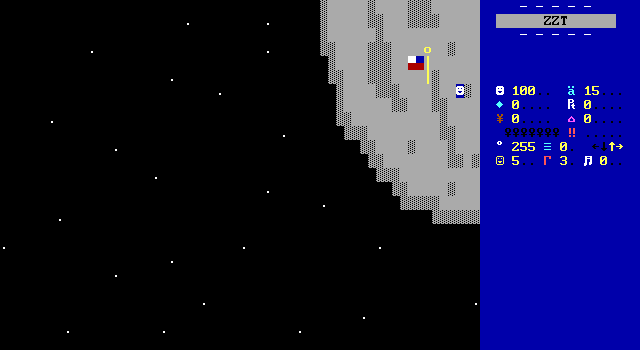
In the moonshot ending, players find an alien spacecraft on the moon, with a locked door they need to open up in order to transport themselves back to Earth. There's no key, so improvising is necessary. Fletcher has to grab the flagpole left behind by Apollo 11, and then sharpen it into a point in a cave where the aliens have set up some torches for lighting.
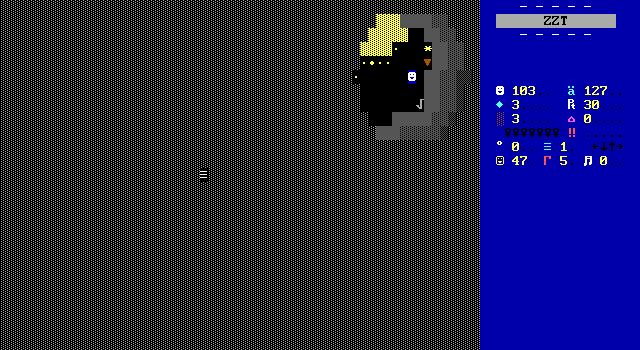
A pre-zapped label in the torch's fire code lets Fletcher melt the pole and sharpen it against the wall. Baffling transformation aside, nothing in the game's code ever leads to the torch restoring the label, resulting in touching the fire have no effect.
It's hard to say what happened here with any confidence. Was there originally a different message when touching the fire? Did an object accidentally get erased that would constantly check for the flag pole flag?
Regardless of what went wrong, the outcome is an entire ending being locked away. The moon is one of the easier places to get to in Coolness, so I'm sure countless players made it this far, and wasted who knows how much time searching for a way past the lock or a use for the flag pole that isn't there.
Meanwhile, back on Earth, another huge oversight almost prevents players from ever getting into the public pool.
The pool also needs a key to enter. This time, a standard ZZT key. It also requires that the weather be warm, which can only be done by getting to the secret weather machine in the tree house next to Fletcher's house which is blocked off by a locked gate.
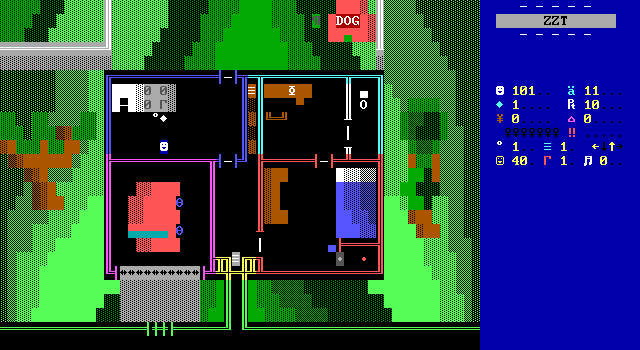
Coolness expects players to shoot a bullet at a stove-top burner to turn it into a gem. (Insane.) That gem is then given to the homeless person behind the lab, who rewards players by showing them the secret backdoor to the bank.
Fletcher then can steal from the bank (aka his workplace) provided that he's shot the security button found in the bushes outside the bank to disable the lasers and force everyone out of the building. Players that can make it inside can then raid a lock-box for the key to the neighbor's gate and another gem.
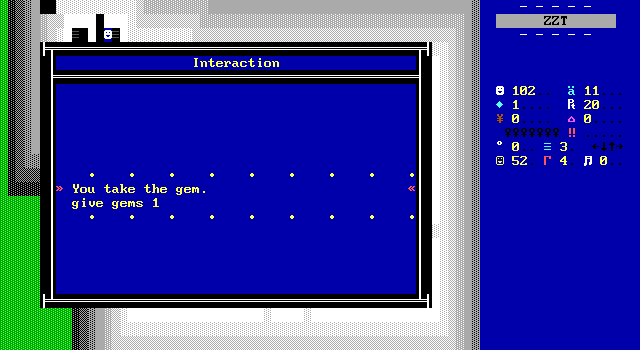
...Or at least they would. Due to a missing # though, the command to increments the player's gems turns into text resulting in only the key being collected.
This would ruin a second ending, even with cheats, as Williams implemented his fair share of anti-cheat code. The ?GEMS cheat gives players five gems, which is more than can be obtained normally. Williams has the lab's transformer look if the player has more gems than should be possible as an anti-cheat measure that chastises and kills players for their heinous crime of trying to adapt to the game's bugs.
But Williams overlooked something! A different bug actually allows the player to get extra gems.
Shooting a bullet at the oven burner when it's off does nothing. When it's on, it hardens into a gem. When you try to do this again, no more gems are produced. However, turning the burner off causes the object to #RESTORE TOUCH so that players can toggle the stove as much as they like. This has an unintended side effect of allowing players to turn the burner on a second time and get another "first" gem from shooting it.
Using this technique it's possible to convert all of the player's ammo into gems. This isn't particularly helpful since having too many gems will cause the player to be accused of cheating. Using it once to get a single extra gem will at least allow players to make up for the one they can't acquire in the bank, making the ending actually possible to reach.
The same issues persist both in the unregistered and registered releases of the game, so whether you play the original public release or the registered version published under Software Visions, you are probably going to have to crack open the cheat prompt at some point.
Coolness is yet another beloved ZZT game where its reputation of being a high quality world comes under fire when you actually go back to it. These issues are pretty bad, yet you'll run into similar issues in Code Red, Sivion, and who knows what else. If covering these games has taught me anything, it's that ZZTers, understanding the difficulty of creating a bug-free game, and with easy access to an editor and cheats to get past most problems, just did not dwell on these mistakes for very long. I'm just really glad that I played this and Code Red originally so close to one another, lest I wound up bad-mouthing one while praising the other.
Cool Puzzles
There are times though where Coolness really does live up to its name. Even players that never manage to make their way to an ending, are certain to blunder their way into a few of William's better puzzles in the game. Just as with Code Red, the most memorable portions of the game are the early ones, exactly where these puzzles are found.
It's a bit lopsided really. The Folga3 ending is very puzzle heavy, while the other endings are much more sparse and less interesting when they do show up.
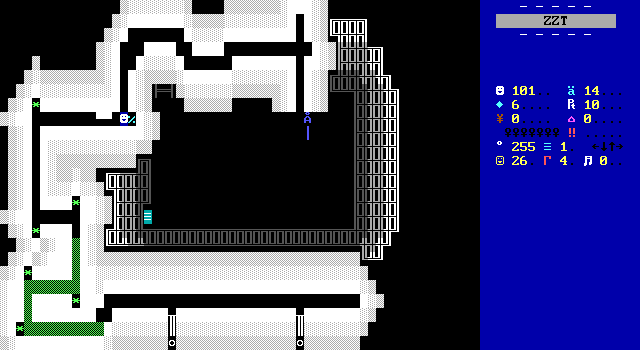
Starting with the weaker of the game's two most memorable puzzles, is the gas station basement. The attendant mentions that the pumps aren't working for some unknown reason, and so Fletcher decides to do some impromptu repair work.
In the piping, an outbreak of green gunk has spread, preventing gasoline from reaching the station's pumps. Fletcher needs to clear out the gunk and make them operational once more.
Unfortunately, the piping is too narrow to fit inside, requiring bullets to be shot inside while Fletcher repeatedly operates a switch which shifts the positioning of the various ricochets that line the pipe.
With some well-timed presses, the bullet will be deflected down the pipe and shoot a breakable wall.
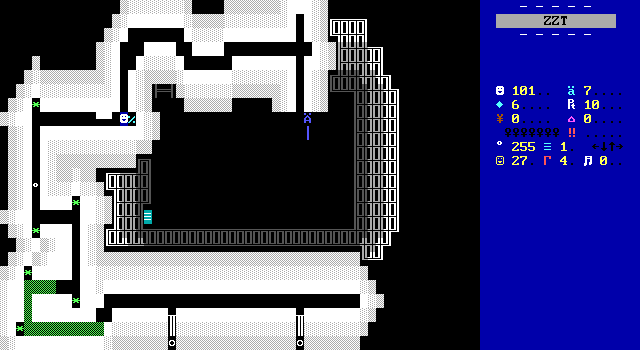
It's fun, at least at first. With only a single button to interact with once the bullet has been fired, the puzzle is really a matter of mastering timing. Yet the consequence for failure is fairly light.
Though some particularly poor timing can lead to the bullet striking a wall and disappearing, the pipe is laid out so that a ricochet in the wrong position merely causes the bullet to bounce back and forth indefinitely. You're intended to slowly step through the puzzle, bouncing back and forth until you're confident you're on a good cycle to make it to the next segment.
This also means that with perfect timing, it's possible to send a bullet all the way through the pipe without it ever bouncing backwards at all, and it's incredibly satisfying to do so.
There are still two issues here that are clear places where the experience can be improved. Firstly, it gets repetitive. Like, immensely so. There are twenty-two breakables that need to be cleared out. The first few require three bounces, increasing up to six by the end of it.
The challenge here is in the execution, so I understand why there's a need for more than just one breakable, but even halving the number of breakables would probably have dragged on a bit too long. The solution is the same every time, so it doesn't take long before the puzzle wears out its welcome.
The other issue is that the unclogging process requires the player to use their own supply of ammo. Unless the player has already discovered the hidden rocket ship which contains forty shots, the only other ammo available up to this point is from the drawers in the Long residence. Drawers, which may I remind you, only contain fifteen ammo.
I am positive as a child I managed to use all my starting ammo on this puzzle and never figured out where to get more to be able to finish it.
To be fair to Williams, players that have yet to find the rocket ship don't even know why they'd want to fix the gas pumps, only operating on the logic that since they can be fixed, they must need to be. Still, halving the breakables would simultaneously solve both problems, as would shooting down the pipe via an object rather than the player.
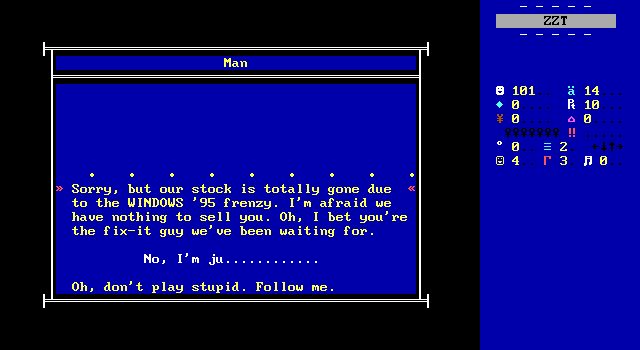
For a puzzle you won't soon forget (in a good way), the computer store trounces the gas station. In the computer store, Fletcher is assumed to be a repairman for some sort of electrical equipment. (I also love this Windows 95 call-out that firmly dates the game.)
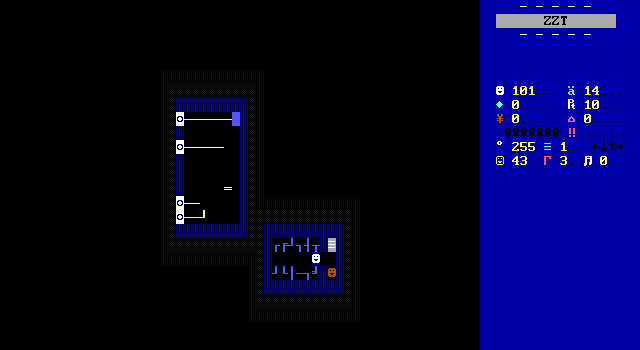
This puzzle is entirely done with objects, and is really quite impressive for the era. Upon starting, the room the player is in will have a number of objects appear each using various ASCII box drawing characters for its graphic. In the other room, a blue solid tile appears to indicate where the wiring will be placed.
Players then pick a wire, set it in place, and the blue indicator moves to the next position. Repeat until all the wires are placed properly, forming a closed circuit.
The difficulty here comes from not knowing where the indicator will move next after placing a tile. On your first attempt, you're likely to accidentally put something in the wrong spot. Players need to study the layout carefully to make sure that everything stays connected. Some of the wires are also the double line characters, so it's important to pay attention to those connections as well.
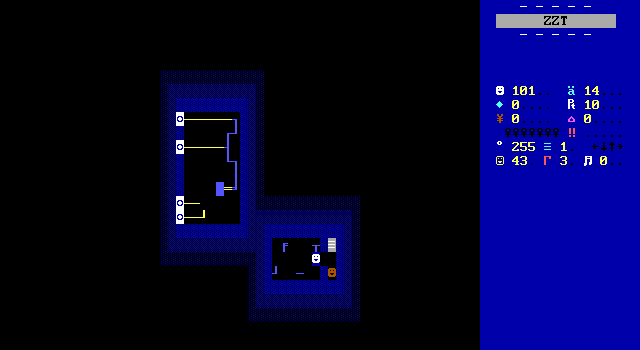
Players are free to make mistakes as much as needed though. If you screw up, the puzzle resets itself and can be attempted again and again. Here too, there can be a bit of tedium though, as once you realize you've made a mistake, there's no way to reset the puzzle other than placing all the tiles, forcing players to start mashing every remaining wire haphazardly.
Outside of ZZT, this would be a very simple puzzle you'd expect to be used as a metaphor for hacking probably. In ZZT, it's a bit more complex to pull off. Each tile has to be individually placed, react to every possible tile it can be, and properly forward player inputs to the currently highlighted location in the circuit. Back in 1996, this kind of thing would have been pretty remarkable in action.
Less Cool Puzzles
Coolness puts its best foot forward with those two designs. Later on, depending on path, players have extra puzzles to solve. These aren't as engaging or creative, but are pretty much the only thing to try and challenge players as the game is very much devoid of action.
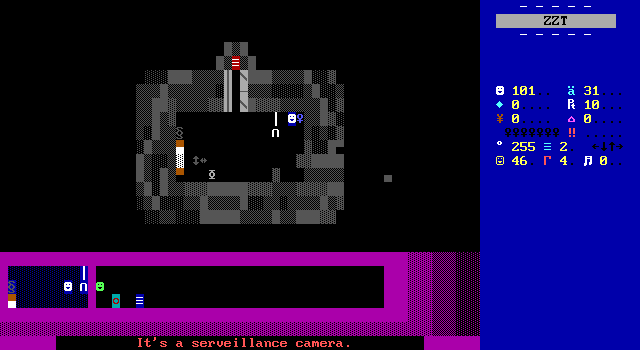
Take for instance, Folga3's jail cell escape. Breaking out of prison, is a time honored tradition in ZZT. Countless critical items have been hidden under uncomfortable pillows, left soaking in filthy toilets, or foolishly delivered to players with their meals. Since so many authors put these sequences in at least one game, it turns into an opportunity to express oneself, to differentiate from the rest and make your prison escape the coolest one of all.
This one isn't anything too exciting.
The pillow contains a pin under it. The pin can be used to pick a ball and chain. Freeing the ball immediately though is a terrible mistake, as the player is actively monitored by a security camera in the corner which will throw stars to deter would-be escapees.
The stars can be blocked by hiding on the side of the sink which defeats the purpose of the camera. The sink can be used to truly defeat the camera by disconnecting the pipe, but the game only allows players to do so on one side which can get confusing.
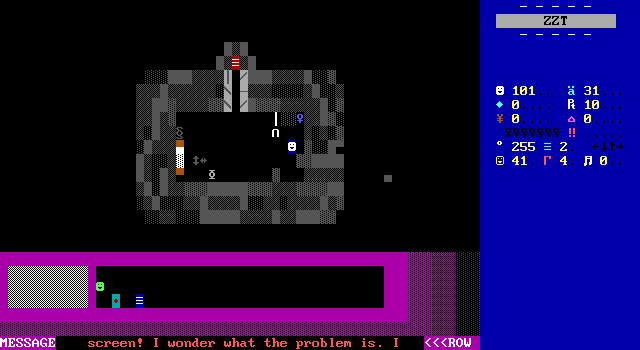
Disconnecting the sink causes the camera to be splashed with a jet of water and short circuit. Meanwhile the guard in the room below will notice the malfunction and attempt to mess with some electronics himself only to become electrocuted.
This is where things get weird. From here the player needs to roll the ball around, which continues moving in the direction it was pushed until it strikes something. The sliders and a rock that can only be moved once are positioned in order to get the ball towards the corner, where a row of breakable walls can be smashed to pieces.
This gets Fletcher outside where he begins to run around in a dark void? To me this board is meant to depict two rooms at once, the cell, and the guard monitoring Fletcher from afar. I don't look at this and think two connected rooms because the outside of the cell is just empty.
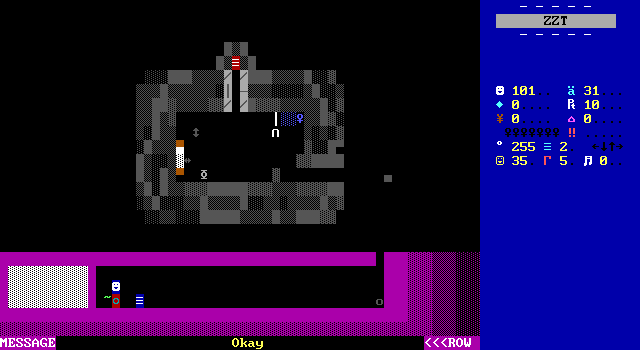
Williams sees it differently. You're actually supposed to keep pushing the ball down to smash open the room to where the now-fried alien guard is. Something about all this seems off to me.
Oh, and there is an oversight where the player can still shoot on this board. The actual breakables that make up the cell walls make it possible to get out that way. The objects that the ball is supposed to break also break when blocked by a bullet though the timing needs to line up as they do try to recognize if they're being blocked by the player or not. Alternatively, you can just shoot the breakables that make up the intended walls and get out that way.
The prison break is okay. The intended solution is hardly any more out there than any other escape. That just means it's something players have seen time and time again before making this puzzle a sensible addition, that lacks the originality seen earlier.
Players that head to the public pool instead of outer space get their own unique puzzle that clearly goes on for too long, making it the most tedious screen in the game by a significant margin.

The back of the pool contains a single metallic boulder for players to push all the way to the end of the board so that it can bridge some wires. This game loves impromptu electrical wiring.
Push the boulder against a wall and it can become impossible to continue moving it forward. The puzzle asks players to clear out some sliders so that they have room to move everything, but it also at times forces players to push the boulder against a wall and operate a button to activate some pistons to reposition it safely.
Like the prison escape, there's nothing about this puzzle that's bad per-se. It's just not that exciting. The trouble with this one though, is that the button used to activate the pistons is found pretty early along the path. Leading to a lot of running back and forth from the boulder to the button, which like the gas station puzzle, is longer every time players have to do it.
I guess the thought here is that players in their hurry might accidentally push a slider they weren't supposed to on their way back, breaking the puzzle. That sucks. I get it. It's 1996. It still sucks.
All of this is so that players can operate two levers that I can't decide if they're supposed to be ambiguous or not. Their object names give away when they do, while the actual descriptions just refer to them as switches that can be flipped. Perhaps the name is supposed to be the hint, or perhaps it's meant to be a guessing game where Williams didn't cover his tracks very well. Regardless of the intent for how players were expected to approach the switches, the solution is to first overflow the pool in order to soak all the explosives, and to then activate the drainage system to get rid of the excess water allowing the player to traverse the board again.
These switches both become stuck when thrown, so you only get one chance to flip each of them. However, even with the right order it's still possible to ruin the puzzle.
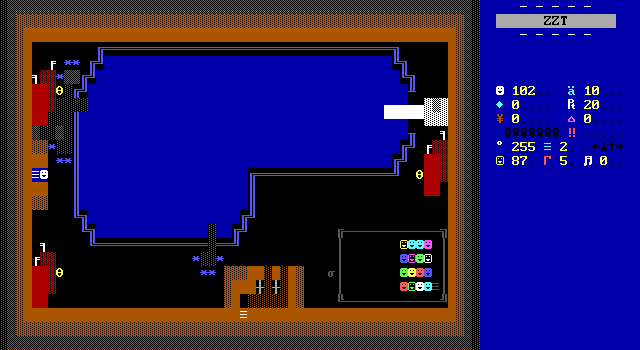
If the overflowing isn't observed by the player, it's as if it never happened. So players need to start pumping in water, return to the pool and watch the dynamite be disabled, then go back inside and flip the switch for the drain. If Fletcher tries to make a run for it during the flooding he'll eventually be surrounded by ZZT's water and unable to move at all. The game does not make an attempt to detect a stuck player and end their game.
If players flip both switches before heading to the surface, the drain kicks in and no water ever spills. You have to do things one at a time.
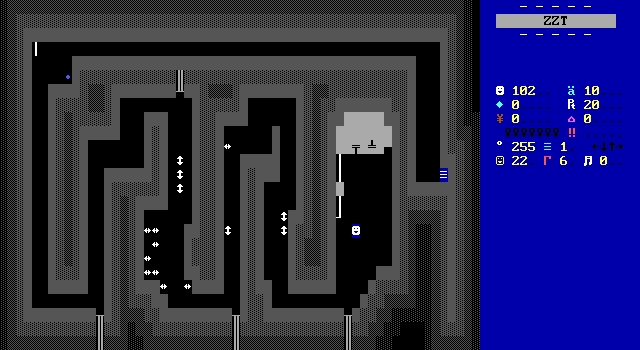
At the very least, there's clear room for improvement by simply removing this narrow section of wall. You'd still have to push the boulder the long way, you just wouldn't have to run the track three times from reaching the switches to being done with them. Just having a slider blocking a pair of transporters would keep the shortcut from being usable until the player reached the switches the first time. It wouldn't save the puzzle, but it would save time.
It's kind of a mess, on an already convoluted path, made worse by having to observe the effect of each switch in order for it to work at all. At their core, the puzzles in Coolness are at least charming, good efforts to come up with some original obstacles for players to unravel, this one is shamefully the exception.
Final Thoughts
If you want to do the obvious thing and compare this game to Code Red, you'll leave satisfied. Williams put together a high quality game for ZZT in 1996 whose origins are blatant to anybody involved with the ZZT community at the time. There's still enough here that feels unique (the puzzles in the shops, the swimming pool ending, the attempts at wiggle room before players are committed to a path), even if the similarities are impossible to miss. Janson introduced ZZTers to waking up and saving the world, Williams made a game about waking up and saving the world (or swimming pool). It's an original enough game that whether you're hooked on Code Red or find it overrated, that there's enough offered here to still be worth seeing for yourself.
Whether or not it's better than Code Red is extremely subjective. For me, it comes down to the execution. I found Coolness to be the cooler game. It's nicer looking, not nearly as samey as the seemingly endless space stations Janson inevitably beamed players to, and has its own share of small iconic moments with the book of passwords and chasing after Fletcher's unnamed dog. I want to see Coolness as the superior game.
I can't though, because so much of Coolness is clobbered by bugs that leave it feeling significantly jankier now than it did nearly thirty years ago. Code Red is hardly perfect in this department either, but this time the gap in time between the two releases works in favor of Code Red. That game came out in 1993 and was absolutely massive compared to what else was available at the time. It's no surprise that it has coding issues. Coolness is significantly condensed and released with plenty of time to avoid CR's mistakes.
There's a longer gap between Code Red and Coolness than there is between Town and Code Red. The bar for a high quality game has skyrocketed. We're in the era of Ned The Knight, whose preview build arrived in September 95. The Gold edition of Fred! Episode 2 has been around even longer. Sivion is a hot mess, but it's a beloved hot mess, whose reputation was still at its peak. Code Red had the luxury of standing alone, Coolness is one of several great games with issues. You can do more with Code Red without running into trouble while this game only has a one in three chance of your ending being reachable without cheating.
But at the same time that's not fair to Coolness either. It's 2024, you can download both games before you finish reading this sentence.
On its own terms, as just another new ZZT world to experience, Coolness has a lot going for it. Bugs, which plague an unfortunate number of other worlds don't seem as harsh when looking at every game that surrounds it. Instead you get to appreciate everything Coolness is still doing right. It is an open-ended adventure that delivers on the promise of multiple endings, and can do so with much more confidence than games whose idea of an alternate ending is just whether Earth or Mars blows up at the end. The town explored in the game might not be particularly large, yet it offers one of the most grounded in reality assortment of buildings for players to enter (save the lab). His town has a bank, a computer store, a gas station, a public pool. Normal things that sell the idea that this is a normal town that is hiding some secrets quite well. Visually, it still holds up wonderfully, with its opening half of the town being fantastic for the era, and still great today.
The only real complaints here that aren't the bugs and aren't a result of direct comparison to Code Red is that the puzzles can drag on and the paths can be difficult to initially discover. This is the sort of game you were meant to sink a lot of time into, a style that has fallen out of favor, especially in ZZT these days. The ways it do so are expected for the time, and arguably what people wanted. Going into it now, you can feel that this is a ZZT game from the mid-90s and not something trying to capture that essence in present day. It remains a classic in my eyes, and no amount of gunk in the pipeline will change my mind.


